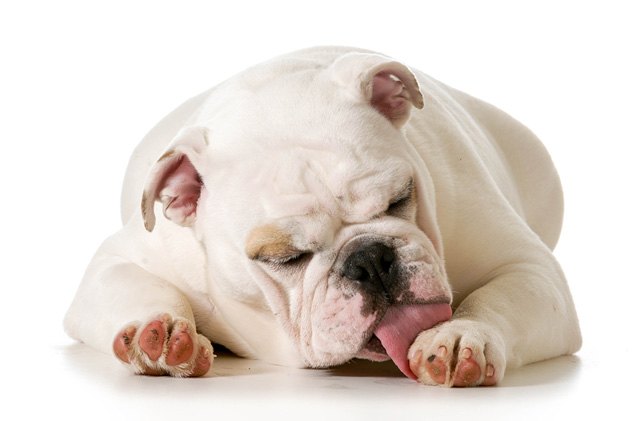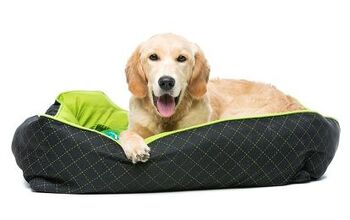Watching your dog try to find a place to relax can make you dizzy! Have you ever wondered why do dogs circle before they lie down? It’s time to finally find out.
Every person who has ever owned a dog can agree on one thing: pooches can be real weirdos. Seriously, dogs do some strange things and the reasons behind this weirdness are not always that obvious. Well, at least not to our human brains. Dog brains are a very different mental beast. For instance, doggos like to hump things they find precious (e.g. your leg) or make eye contact with their owners while they poop in the backyard. Dogs, not owners, just to be clear (although no judgement on our part if you are the exception to the rule). Your dog probably has a variety of quirks of his own that make him uniquely freaky, but one those strange behaviors that most dogs exhibit is circling before they lie down. You know, that little ciruclar march they make before plopping down for a rest. So many dogs do it that we never really think about how odd the behaviour seems. We just assume it’s normal without ever wondering, why the heck do dogs do that?
It’s such a common dog habit that we just take it as it is, without stopping to think that the fact that a dog is going in circles around the place they sleep before lying down is plain unusual. Well, not to worry, scientists and canine behaviorists have cracked this mysterious pooch quirk for all of us curious pet parents out there. And it turns out the answer is not as simple and as straightforward as you might think: there are a few different factors that come into play with this odd habit. So, if you’ve always desperately wondered why your pooch takes a lap before having a lie down, you’ve come to the right place. Keep your eyes glued to this page and scroll away. All will be revealed…
Your Dog’s Natural Instincts
As you might have expected, the answer to the secret reason behind your dog’s unusual yet common behavior lies in his ancestry. This isn’t exactly a habit that dogs developed overnight, but an instinct buried deep within their psyche for generations upon generations. Your dog might not look anything like a wolf, but he’s descended from wild dogs and still has carry-over natural instincts. For instance, one of those residual ancestral instincts is scent marking by urine, or burrowing under blankets to feel safer, comfier and satisfy their denning instincts. Though animal behavior experts don’t unanimously agree, some believe that circling before lying down is a residual behavior leftover from a dog’s days living in the wild. Before lying down on the ground, wild wolves sometimes turn in circles to stamp down the grass or snow to create a more level surface – it’s almost like creating a nest. A simple action that makes perfect sense in the wild, even if it seems a little odd in your living room.
Related: Do Dogs Feel Empathy?
Additionally, going around the place where they will sleep could help chase away any potential dangers from the tall grass (such as snakes or insects). While potentially very dangerous for mammals, those dangerous critters are easily scared by sound and movement and this seemingly quirky canine behavior would serve that purpose. The circling would, essentially, help your pet’s ancestor make their bed comfy and safe. All it takes is just one (or few) laps around the potential sleeping spot.
Wild dogs have also been known to dig into the earth to create a hole before lying down in it, allowing the earth to help retain the dog’s natural body heat. This may also explain why some dogs scratch or paw at their bedding before they curl up to rest. They are satisfying dormant instincts that were once crucial to their survival. The ancestors of our domesticated pets were denning animals, and small, cozy, enclosed spaces help them relax and feel safe, which is why envelop or nest dog beds are so popular with pampered pooches. In the far past, what’s now a sherpa-lined soft cave was essentially a deep hole in the dirt. Canines have come a long way, suffice it to say! No more dirt holes for them anymore, certainly not in your living room.
While the improvements and advancement of the canine life and habits are clear, there are still many of the old instincts that survive and are as strong as they were when dogs roamed the wild- even if they are unnecessary in the modern times. However, even though it’s highly likely that your dog’s circling habits are remnants of ancestral instincts, there are also other potential causes at play. So, let’s explore some other potential reasons for canine circling other that aren’t linked to ancestry.
Could Circling Be a Cause for Concern?
As you know, sometimes there’s no obvious explanation for why dogs do certain things. Sometimes it’s simply a habit the dog formed and it may not really have any motivation behind it. But if you can’t think of a reasonable explanation for why your dog is exhibiting a certain behavior, you may want to look into it a little bit more – especially if it’s a new behavior your dog has recently developed. It’s a good rule of thumb for dog behavior in general, mind you: if it’s new, keep an eye on it just in case. And the reason for this vigilant monitoring of your pooch’s quirks is quite simple.
It’s part of a dog’s natural instinct to hide his pain and weakness. If something is wrong, your dog will probably try to mask it because any weakness could make him vulnerable. Because a dog can’t come out and tell you what is wrong, you have to learn to recognize the signs. In a nutshell, not only that dogs can’t tell you that they are hurting, it’s probable they will also try to cover up the fact- another instinctual act. So, it’s up to you to catch the signs early.
Related: Why Does My Dog Keep Licking His Paws?
In many cases, when something is wrong, the first sign you are likely to notice is a change in behavior. If your dog doesn’t usually circle before he lies down but suddenly starts to do it, you might want to look a little deeper into this change in behavior. In some cases, this kind of behavior could be a sign of restlessness or discomfort. It’s indicative that your dog is trying to deal with a larger issue and seeking comfort in this behavioral pattern.
If your dog can’t seem to get comfortable and keeps circling and circling, it may be a sign of a neurological issue or it could be that something is causing him pain – arthritis is a common cause. Watch your dog closely to see if he is having trouble getting up and lying down then decide if you should take him to the vet for a checkup. While a dog circling could be a harmless habit, if this is something that your dog is suddenly doing rather than a longterm pattern, then it is a sign that something has gone wrong. This isn’t a habbit that dogs just suddenly pick up. It’s a sign that something is wrong and they are reverting to this behavior to cope.
Dogs are unique creatures and we don’t always understand why they do the things they do. Because changes in behavior can signal a health problem, you need to familiarize yourself with your dog’s behavior enough that you are able to quickly identify changes. Don’t worry – it’s easy to do! All you have to do is spend as much time with your dog as possible and you’ll come to know him as well as you know yourself – or better.

























